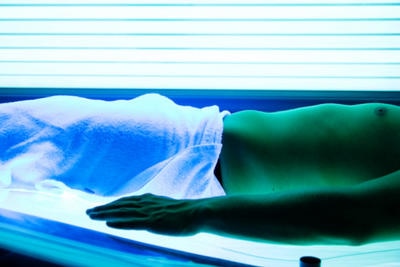Oh we WILL see much, much more of this from the 'Nanny' Government in the near future. With the passage of 'FORCED' NoBamacare anything that the Government deems "un-healthy" will be banned from our lives.
Enjoy a shake and fries before they are banned by our 'Nanny' Government.

Federal health experts say more restrictions are needed to protect users from the cancer risks of tanning beds, including a potential ban for people under 18.
A panel of advisers to the Food and Drug Administration recommended Thursday that the agency put tighter controls on artificial tanning, ranging from requiring parental consent forms in people under the age of 18 to banning the practice in younger teens.
More than 30 states already have tanning salon regulations in place — including a handful that require parental consent for young users — but new FDA requirements would apply nationally.
The panel also recommended the FDA add bolder warning labels to tanning beds and change how they are regulated.
The FDA has regulated sunlamps for more than 20 years, but a recent report by the World Health Organization tied the devices to skin cancer, prompting a call for tougher rules.
The WHO analysis showed that the deadliest form of skin cancer increases 75 percent in people who use tanning beds in their teens and 20s.
The panel also recommended the FDA add bolder warning labels to tanning beds and change how they are regulated.
Currently the machines are classified as low-risk devices, in the same group as bandages and tongue depressors. By increasing their classification to Class II, the FDA could limit the levels of radiation the devices emit and make other changes to their design.
The FDA is not required to follow the advice of its expert panels, though it often does.
Over the course of five hours, dozens of physicians and skin cancer survivors urged the FDA to ban indoor tanning for cosmetic uses, citing the dangers to younger Americans.
Dr. William James, president of the American Academy of Dermatology Association, said his group has seen a startling increase in skin cancer among women in their teens and 20s.
"What was formerly considered a disease of older men is ballooning in young women, the very target audience and number one customer of the tanning industry," James said.
The Indoor Tanning Association says the evidence linking suntan lamps to cancer is drawn from decades-old studies that were merely lumped together and reanalyzed by the WHO.
"FDA has known about the risks of 'ultraviolet' exposure for years, and has discussed the literature in multiple forums," said Dan Humiston, the group's president. "The literature hasn't changed."
Humiston's group represents about 18,000 tanning operations along with manufacturers, including Indianapolis-based ETS Tan and Heartland Tanning Supply of Lee's Summit, Mo.
The tanning industry has long argued that sunlamps can be an important source of Vitamin D, which is needed for healthy blood and strong bones.
But both FDA scientists and other speakers dismissed that argument, pointing out that similar benefits can be had from dietary supplements.[PPE:The government wants us to take a pill]
Earlier this year the Federal Trade Commission charged the Indoor Tanning Association with making false claims about the health benefits of their products. The group has entered a settlement agreement with the government and pulled the ads in question.
The indoor tanning industry is approximately a $5 billion sector that is already being squeezed by a 10 percent tax on tanning included in the health overhaul plan that became law earlier this week.
Nearly 69,000 U.S. cases of melanoma, the most dangerous form of skin cancer, were diagnosed last year. Also linked to ultraviolet exposure are basal and squamous cell cancer carcinomas, which affect more than 1 million Americans a year. They're usually easily removed but the American Cancer Society counts 2,000 annual deaths.
Fair-skinned people who don't tan easily are at highest risk for skin cancer. Melanoma is particularly linked to sunburns at a young age, though it is usually diagnosed in the 40s and 50s.








ROBBERY.jpg)


















